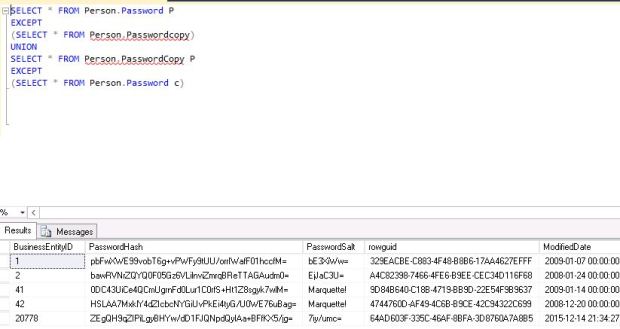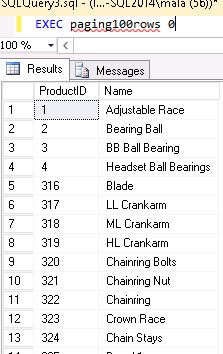
This is my first response to a TSQL Tuesday.
There are lot of things in TSQL that can be done to make DBA’s life easier. We have a large collection of scripts. These are some I have used over the years at multiple jobs – there are several more but I don’t particularly want to write a very long post. Also a disclaimer that I did not write all of them. I wrote some, I tweaked some I found on sites like SQLServerCentral.com that have come in very handy. I apologize ahead for not offering credit since I have not kept track of the authors.
–Find the last server start date(2005)
SELECT crdate AS Datetime_Started FROM sysdatabases WHERE name = ‘tempdb’
1 –Find Blank passwords
SELECT name FROM sys.syslogins WHERE pwdcompare(””, password) = 1
2 –Find members of a role (for example, public)
SELECT a.[name] + ‘ ‘ + v.[name] + ‘ ON ‘ + QuoteName(oo.[name]) + ‘.’ + QuoteName(o.[name]) + ‘ TO ‘ + QuoteName(u.[name])
FROM dbo.sysprotects AS p JOIN master.dbo.spt_values AS a
ON (a.number = p.protecttype AND ‘T’ = a.type) JOIN master.dbo.spt_values
AS v ON (v.number = p.action AND ‘T’ = v.type) JOIN dbo.sysobjects AS o ON (o.id = p.id)
JOIN dbo.sysusers AS oo ON (oo.uid = o.uid) JOIN dbo.sysusers AS u ON (u.uid = p.uid) WHERE ‘public’ = u.name
3 –Find number of times a stored procedure was used since last reboot
SELECT DB_NAME(st.dbid) DBName
,OBJECT_SCHEMA_NAME(st.objectid,dbid) SchemaName
,OBJECT_NAME(st.objectid,dbid) StoredProcedure
,max(cp.usecounts) Execution_count
FROM sys.dm_exec_cached_plans cp
CROSS APPLY sys.dm_exec_sql_text(cp.plan_handle) st
where DB_NAME(st.dbid) is not null and cp.objtype = ‘proc’
group by cp.plan_handle, DB_NAME(st.dbid),
OBJECT_SCHEMA_NAME(objectid,st.dbid),
OBJECT_NAME(objectid,st.dbid)
order by max(cp.usecounts)
4 –Stick in anything to be changed across all dbs (just used sp_dboption with read only here)
SET NOCOUNT ON
— Get the name of all databases
DECLARE UserDatabases CURSOR FOR
SELECT name FROM master..sysdatabases
where name not in (‘master’,’tempdb’, ‘model’, ‘msdb’, ‘distribution’)
— Open Cursor
OPEN UserDatabases
— Define variables needed
DECLARE @DBase NVARCHAR(128)
DECLARE @COMMAND NVARCHAR(128)
— Get First database
FETCH NEXT FROM USerDatabases INTO @DBase
— Process until no more databases
WHILE (@@FETCH_STATUS = 0)
BEGIN
set @command =’master..sp_dboption @dbname=”’ + @dbase +
”’,@optname=”Read ONLY”, @optvalue=”True”’
— Print command to be processed
print @command
— Process Command
exec (@command)
— Get next database
FETCH NEXT FROM UserDatabases INTO @DBase
END
— Close and Deallocate Cursor
CLOSE AllDatabases
DEALLOCATE AllDatabases
5 —-My favorite, lists job calender
USE MSDB
DECLARE
@JOB_ID VARCHAR(200),
@SCHED_ID VARCHAR(200),
@FREQ_TYPE INT,
@FREQ_INTERVAL INT,
@FREQ_SUBDAY_TYPE INT,
@FREQ_SUBDAY_INTERVAL INT,
@FREQ_RELATIVE_INTERVAL INT,
@FREQ_RECURRENCE_FACTOR INT,
@ACTIVE_START_DATE INT,
@SCHEDULE VARCHAR(1000),
@SCHEDULE_DAY VARCHAR(200),
@START_TIME VARCHAR(10),
@END_TIME VARCHAR(10)
CREATE TABLE #SCHEDULES
(JOB_ID VARCHAR(200),
SCHED_ID VARCHAR(200),
JOB_NAME SYSNAME,
[STATUS] INT,
SCHEDULED INT NULL,
schedule VARCHAR(1000) NULL,
FREQ_TYPE INT NULL,
FREQ_INTERVAL INT NULL,
FREQ_SUBDAY_TYPE INT NULL,
FREQ_SUBDAY_INTERVAL INT NULL,
FREQ_RELATIVE_INTERVAL INT NULL,
FREQ_RECURRENCE_FACTOR INT NULL,
ACTIVE_START_DATE INT NULL,
ACTIVE_END_DATE INT NULL,
ACTIVE_START_TIME INT NULL,
ACTIVE_END_TIME INT NULL,
DATE_CREATED DATETIME NULL)
INSERT INTO #SCHEDULES (
job_id,
sched_id ,
job_name ,
[status] ,
Scheduled ,
schedule ,
freq_type,
freq_interval,
freq_subday_type,
freq_subday_interval,
freq_relative_interval,
freq_recurrence_factor,
active_start_date,
active_end_date,
active_start_time,
active_end_time,
date_created)
SELECT
j.job_id,
sched.schedule_id,
j.name ,
j.enabled,
sched.enabled,
NULL,
sched.freq_type,
sched.freq_interval,
sched.freq_subday_type,
sched.freq_subday_interval,
sched.freq_relative_interval,
sched.freq_recurrence_factor,
sched.active_start_date,
sched.active_end_date,
sched.active_start_time,
sched.active_end_time,
j.date_created
FROM sysjobs j
inner join
sysjobschedules s
ON j.job_id=s.job_id
INNER JOIN dbo.sysschedules sched
ON s.schedule_id = sched.schedule_id
WHILE 1=1
BEGIN
SET @SCHEDULE = ”
IF (SELECT COUNT(*) FROM #SCHEDULES WHERE scheduled=1 and schedule is null) = 0
BREAK
ELSE
BEGIN
SELECT
@job_id=job_id,
@sched_id=sched_id,
@freq_type=freq_type,
@Freq_Interval=freq_interval,
@freq_subday_type=freq_subday_type,
@freq_subday_interval=freq_subday_interval,
@freq_relative_interval=freq_relative_interval,
@freq_recurrence_factor=freq_recurrence_factor,
@active_start_date = active_start_date,
@start_time =
CASE
WHEN
LEFT(active_start_time, 2) IN (22, 23) AND len(active_start_time) = 6
THEN
convert(varchar(2), left(active_start_time, 2) – 12)
+ ‘:’ + SUBSTRING(CAST(active_start_time AS CHAR),3, 2) + ‘ P.M’
WHEN
left(active_start_time, 2) = (12) AND len(active_start_time) = 6
THEN
cast(LEFT(active_start_time,2) as char(2))
+ ‘:’ + SUBSTRING(CAST(active_start_time AS CHAR),3, 2) + ‘ P.M.’
WHEN
left(active_start_time, 2) BETWEEN 13 AND 24 AND len(active_start_time) = 6
THEN
convert(varchar(2), left(active_start_time, 2) – 12)
+ ‘:’ + SUBSTRING(CAST(active_start_time AS CHAR),3, 2) + ‘ P.M.’
WHEN
left(active_start_time, 2) IN (10, 11) AND len(active_start_time) = 6
THEN
cast(LEFT(active_start_time,2) as char(2))
+ ‘:’ + SUBSTRING(CAST(active_start_time AS CHAR),3, 2) + ‘ A.M.’
WHEN
active_start_time = 0
THEN
’12:00 A.M.’
WHEN
LEN(active_start_time) = 4
THEN
’12:’ + convert(varchar(2), left(active_start_time, 2) ) + ‘ A.M.’
WHEN
LEN(active_start_time) = 3
THEN
’12:0′ + convert(varchar(2), left(active_start_time, 1) ) + ‘ A.M.’
WHEN
LEN(active_start_time) = 2
THEN
’12:00:’ + convert(varchar(2), left(active_start_time, 2) ) + ‘ A.M.’
WHEN
LEN(active_start_time) = 1
THEN
’12:00:0′ + convert(varchar(2), left(active_start_time, 2) ) + ‘ A.M.’
ELSE
cast(LEFT(active_start_time,1) as char(1))
+ ‘:’ + SUBSTRING(CAST(active_start_time AS CHAR),2, 2) + ‘ A.M.’
END,
@END_TIME= CASE
WHEN
left(active_end_time, 2) IN (22, 23) AND len(active_end_time) = 6
THEN
convert(varchar(2), left(active_end_time, 2) – 12)
+ ‘:’ + SUBSTRING(CAST(active_end_time AS CHAR),3, 2) + ‘ P.M’
WHEN
left(active_end_time, 2) = (12) AND len(active_end_time) = 6
THEN
cast(LEFT(active_end_time,2) as char(2))
+ ‘:’ + SUBSTRING(CAST(active_end_time AS CHAR),3, 2) + ‘ P.M.’
WHEN
left(active_end_time, 2) BETWEEN 13 AND 24 AND len(active_end_time) = 6
THEN
convert(varchar(2), left(active_end_time, 2) – 12)
+ ‘:’ + SUBSTRING(CAST(active_end_time AS CHAR),3, 2) + ‘ P.M.’
WHEN
left(active_end_time, 2) IN (10, 11) AND len(active_end_time) = 6
THEN
cast(LEFT(active_end_time,2) as char(2))
+ ‘:’ + SUBSTRING(CAST(active_end_time AS CHAR),3, 2) + ‘ A.M.’
WHEN
active_end_time = 0
THEN
’12:00 A.M.’
WHEN
LEN(active_end_time) = 4
THEN
’12:’ + convert(varchar(2), left(active_end_time, 2) ) + ‘ A.M.’
WHEN
LEN(active_end_time) = 3
THEN
’12:0′ + convert(varchar(2), left(active_end_time, 1) ) + ‘ A.M.’
WHEN
LEN(active_end_time) = 2
THEN
’12:00:’ + convert(varchar(2), left(active_end_time, 2) ) + ‘ A.M.’
WHEN
LEN(active_end_time) = 1
THEN
’12:00:0′ + convert(varchar(2), left(active_end_time, 2) ) + ‘ A.M.’
ELSE
cast(LEFT(active_end_time,1) as char(1))
+ ‘:’ + SUBSTRING(CAST(active_end_time AS CHAR),2, 2) + ‘ A.M.’
END
FROM #SCHEDULES
WHERE schedule is null
AND scheduled=1
IF EXISTS(SELECT @freq_type WHERE @freq_type in (1,64))
BEGIN
SELECT @SCHEDULE = CASE @freq_type
WHEN 1 THEN ‘Occurs Once, On ‘+cast(@active_start_date as varchar(8))+’, At ‘+@start_time
WHEN 64 THEN ‘Occurs When SQL Server Agent Starts’
END
END
ELSE
BEGIN
IF @freq_type=4
BEGIN
SELECT @SCHEDULE = ‘Occurs Every ‘+cast(@freq_interval as varchar(10))+’ Day(s)’
END
IF @freq_type=8
BEGIN
SELECT @SCHEDULE = ‘Occurs Every ‘+cast(@freq_recurrence_factor as varchar(3))+’ Week(s)’
SELECT @schedule_day=”
IF (SELECT (convert(int,(@freq_interval/1)) % 2)) = 1
select @schedule_day = @schedule_day+’Sun’
IF (SELECT (convert(int,(@freq_interval/2)) % 2)) = 1
select @schedule_day = @schedule_day+’Mon’
IF (SELECT (convert(int,(@freq_interval/4)) % 2)) = 1
select @schedule_day = @schedule_day+’Tue’
IF (SELECT (convert(int,(@freq_interval/8)) % 2)) = 1
select @schedule_day = @schedule_day+’Wed’
IF (SELECT (convert(int,(@freq_interval/16)) % 2)) = 1
select @schedule_day = @schedule_day+’Thu’
IF (SELECT (convert(int,(@freq_interval/32)) % 2)) = 1
select @schedule_day = @schedule_day+’Fri’
IF (SELECT (convert(int,(@freq_interval/64)) % 2)) = 1
select @schedule_day = @schedule_day+’Sat’
SELECT @SCHEDULE = @SCHEDULE+’, On ‘+@schedule_day
END
IF @freq_type=16
BEGIN
SELECT @SCHEDULE = ‘Occurs Every ‘+cast(@freq_recurrence_factor as varchar(3))+’ Month(s) on Day ‘+cast(@freq_interval as varchar(3))+’ of that Month’
END
IF @freq_type=32
BEGIN
SELECT @SCHEDULE = CASE @freq_relative_interval
WHEN 1 THEN ‘First’
WHEN 2 THEN ‘Second’
WHEN 4 THEN ‘Third’
WHEN 8 THEN ‘Fourth’
WHEN 16 THEN ‘Last’
ELSE ‘Not Applicable’
END
SELECT @SCHEDULE =
CASE @freq_interval
WHEN 1 THEN ‘Occurs Every ‘+@SCHEDULE+’ Sunday of the Month’
WHEN 2 THEN ‘Occurs Every ‘+@SCHEDULE+’ Monday of the Month’
WHEN 3 THEN ‘Occurs Every ‘+@SCHEDULE+’ Tueday of the Month’
WHEN 4 THEN ‘Occurs Every ‘+@SCHEDULE+’ Wednesday of the Month’
WHEN 5 THEN ‘Occurs Every ‘+@SCHEDULE+’ Thursday of the Month’
WHEN 6 THEN ‘Occurs Every ‘+@SCHEDULE+’ Friday of the Month’
WHEN 7 THEN ‘Occurs Every ‘+@SCHEDULE+’ Saturday of the Month’
WHEN 8 THEN ‘Occurs Every ‘+@SCHEDULE+’ Day of the Month’
WHEN 9 THEN ‘Occurs Every ‘+@SCHEDULE+’ Weekday of the Month’
WHEN 10 THEN ‘Occurs Every ‘+@SCHEDULE+’ Weekend Day of the Month’
END
END
SELECT @SCHEDULE =
CASE @freq_subday_type
WHEN 1 THEN @SCHEDULE+’, At ‘+@start_time
WHEN 2 THEN @SCHEDULE+’, every ‘+cast(@freq_subday_interval as varchar(3))+’ Second(s) Between ‘+@start_time+’ and ‘+@END_TIME
WHEN 4 THEN @SCHEDULE+’, every ‘+cast(@freq_subday_interval as varchar(3))+’ Minute(s) Between ‘+@start_time+’ and ‘+@END_TIME
WHEN 8 THEN @SCHEDULE+’, every ‘+cast(@freq_subday_interval as varchar(3))+’ Hour(s) Between ‘+@start_time+’ and ‘+@END_TIME
END
END
END
UPDATE #SCHEDULES
SET schedule=@SCHEDULE
WHERE job_id=@job_id
AND sched_id=@sched_Id
END
SELECT job_name ,
[status] = CASE STATUS
WHEN 1 THEN ‘ENABLED’
WHEN 0 THEN ‘DISABLED’
ELSE ‘ ‘
END,
scheduled= case scheduled
when 1 then ‘Yes’
when 0 then ‘No’
else ‘ ‘
end,
schedule as ‘Frequency’ ,
convert(datetime, convert(varchar,active_start_date, 101)) AS schedule_start_date,
convert(datetime, convert(varchar,active_end_date, 101)) AS schedule_end_date,
date_created
FROM #schedules
WHERE scheduled=1
ORDER BY job_name
DROP TABLE #schedules
I hope you all find something useful. And thank you to Allen White for hosting.





